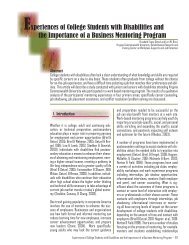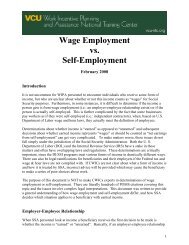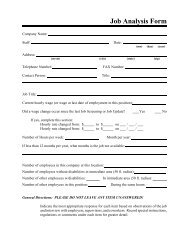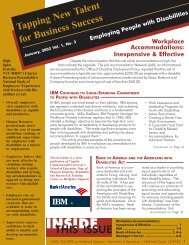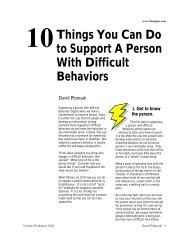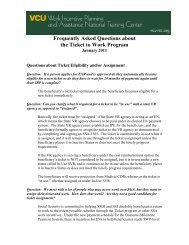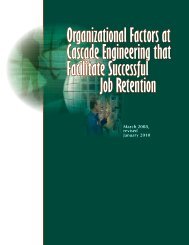Work Incentives Planning and Assistance ... - Worksupport.com
Work Incentives Planning and Assistance ... - Worksupport.com
Work Incentives Planning and Assistance ... - Worksupport.com
You also want an ePaper? Increase the reach of your titles
YUMPU automatically turns print PDFs into web optimized ePapers that Google loves.
<strong>Work</strong> <strong>Incentives</strong> <strong>Planning</strong> <strong>and</strong> <strong>Assistance</strong> Services Defined<br />
From Federal Register / Vol. 71, No. 94 / Tuesday, May 16, 2006<br />
Pages 28405-28406<br />
The primary purpose of the WIPA program is to provide beneficiaries with accurate information<br />
about work incentives programs <strong>and</strong> assist beneficiaries to succeed in their efforts to obtain, retain, or<br />
enhance employment. The services which WIPA projects have <strong>com</strong>mitted to provide were clearly<br />
described in the solicitation for Cooperative Agreements for <strong>Work</strong> <strong>Incentives</strong> <strong>Planning</strong> <strong>and</strong><br />
<strong>Assistance</strong> Projects; Program Announcement No. SSA-OESP-06-1 which was published in the<br />
Federal Register Vol. 71, No. 94, Tuesday, May 16, 2006:<br />
1. <strong>Work</strong> <strong>Incentives</strong> <strong>Planning</strong> Services<br />
<strong>Work</strong> incentives planning services requires an in-depth underst<strong>and</strong>ing of the beneficiary’s<br />
current situation <strong>and</strong> how available work incentives can impact on a beneficiary’s employment<br />
efforts. CWICs will establish written benefits analysis plans for beneficiaries with disabilities<br />
outlining their employment options <strong>and</strong> develop long-term supports that may be needed to ensure<br />
a beneficiary’s success in regards to employment. CWICs will also, based upon a beneficiary’s<br />
needs, make referrals to Employment Networks (ENs) or Vocational Rehabilitation (VR) when<br />
appropriate. CWICs will also provide periodic, follow-up planning services to ensure that the<br />
information, analysis, <strong>and</strong> guidance is updated as new conditions (with regard to the applicable<br />
programs or to the beneficiary’s situation) arise. To provide work incentives planning services,<br />
CWICs will:<br />
<br />
Obtain <strong>and</strong> evaluate <strong>com</strong>prehensive information about a beneficiary with a disability on<br />
the following:<br />
a. Beneficiary’s background information<br />
b. Disabling impairments/conditions<br />
c. Educational <strong>and</strong> vocational background<br />
d. Employment <strong>and</strong> earnings<br />
e. Resources<br />
f. Federal, State <strong>and</strong> local benefits<br />
g. Health insurance<br />
h. <strong>Work</strong> expenses<br />
i. <strong>Work</strong> incentives<br />
j. Service(s) <strong>and</strong> supports
Assess the potential impacts of employment <strong>and</strong> other changes on a beneficiary’s federal,<br />
State <strong>and</strong> local benefits eligibility <strong>and</strong> overall financial well-being;<br />
Provide detailed information <strong>and</strong> assist the beneficiary in underst<strong>and</strong>ing <strong>and</strong> assessing the<br />
potential impacts of employment <strong>and</strong>/or other actions or changes on his/her life situation,<br />
<strong>and</strong> provide specific guidance regarding the effects of various work incentives;<br />
Develop a <strong>com</strong>prehensive framework of possible options available to a beneficiary <strong>and</strong><br />
projected results for each as part of the career development <strong>and</strong> employment process; <strong>and</strong><br />
Ensure confidentiality of all information provided.<br />
2. <strong>Work</strong> <strong>Incentives</strong> <strong>Assistance</strong> Services<br />
<strong>Work</strong> incentives assistance involves the delivery of accurate information <strong>and</strong> direct supports for<br />
the purpose of assisting a beneficiary in determining the most advantageous work incentives to<br />
use in going or returning to work. <strong>Work</strong> incentives assistance also involves providing<br />
information <strong>and</strong> referral (specifically in terms of Ticket assignment to Employment Networks<br />
<strong>and</strong> Vocational Rehabilitation), as well as problem-solving services as needed.<br />
<strong>Work</strong> incentives assistance will generally build on previous planning services <strong>and</strong> include<br />
periodic updates of a beneficiary’s specific information, reassessment of benefit(s) <strong>and</strong> overall<br />
impact, education <strong>and</strong> advisement, <strong>and</strong> additional services for monitoring <strong>and</strong> managing work<br />
incentives to ensure a beneficiary’s success in their employment efforts. To provide work<br />
incentives assistance services, CWICs will:<br />
<br />
<br />
<br />
<br />
<br />
Emphasize employment through the use of work incentives planning, leading to greater<br />
self-sufficiency <strong>and</strong> employment for beneficiaries with disabilities;<br />
Refer beneficiaries to Vocational Rehabilitation (VR), Employment Networks (ENs),<br />
DOL One-Stop Career Centers, as well as other organizations that emphasize/provide<br />
seamless employment-related supports <strong>and</strong> ticket assignments;<br />
Assist beneficiaries with disabilities to resolve problems related to work efforts, higher<br />
education <strong>and</strong> work attainment or continuation of work;<br />
Provide ongoing, <strong>com</strong>prehensive work incentives monitoring <strong>and</strong> management assistance<br />
to beneficiaries who are employed or seeking employment;<br />
Provide long-term work incentives management on a scheduled, continuous basis,<br />
allowing for the planning <strong>and</strong> provision of supports at regular checkpoints, as well as<br />
critical transition points in a beneficiary’s receipt of benefits, improvement of medical<br />
condition, work attempts, training <strong>and</strong> employment;
Provide ongoing direct assistance to a beneficiary in the development of a<br />
<strong>com</strong>prehensive, long-term work plan to guide the effective use of Federal, State <strong>and</strong> local<br />
work incentives. Specific <strong>com</strong>ponents of the plan must address:<br />
a. Desired return to work <strong>and</strong> self-sufficiency out<strong>com</strong>es,<br />
b. Related steps or activities necessary to achieve out<strong>com</strong>es,<br />
c. Associated dates or timeframes,<br />
d. Building on initial work incentives planning efforts including information<br />
gathering, analysis <strong>and</strong> advisement, <strong>and</strong><br />
e. Benefits/financial analysis (pre <strong>and</strong> post-employment);<br />
<br />
Provide intensive assistance to beneficiaries, their key stakeholders, <strong>and</strong> their support<br />
teams in making informed choices <strong>and</strong> establishing employment-related goals. Needed<br />
assistance may include, but is not limited to, the following:<br />
a. Explanations, descriptions, <strong>and</strong> written plans on how SSDI <strong>and</strong> SSI work<br />
incentives programs may lead to self-supporting employment by developing a<br />
Plan for Achieving Self-Support (PASS); the use of Impairment Related <strong>Work</strong><br />
Expenses (IRWEs); the use of a Subsidy; Ability to claim Unincurred Business<br />
Expenses; Continued Payments Under a Vocational Rehabilitation Program (also<br />
known as Section 301); as well as the possibility of reinstatement of benefits<br />
when necessary without filing a new application;<br />
b. Explanations, descriptions, <strong>and</strong> written plans on how the SSI 1619(a) <strong>and</strong> 1619(b)<br />
provisions <strong>and</strong> requirements may lead to self-supporting employment by allowing<br />
for continued medical assistance coverage; Earned Iin<strong>com</strong>e Exclusion (EIE);<br />
Student Earned In<strong>com</strong>e Exclusion (SEIE); Property Essential to Self-Support<br />
(PESS); as well as the possibility of reinstatement of benefits when necessary<br />
without filing a new application;<br />
c. Explanations, descriptions, <strong>and</strong> written plans on how the Trial <strong>Work</strong> Period<br />
(TWP) <strong>and</strong> Extended Period of Eligibility (EPE) provisions may lead to selfsupporting<br />
employment by allowing payment of benefits for a specified period of<br />
time dependent upon the amount of earnings; <strong>and</strong><br />
d. Advocating for work supports on behalf of a beneficiary with other agencies <strong>and</strong><br />
programs, which requires in-person, telephone <strong>and</strong>/or written <strong>com</strong>munication with<br />
the beneficiaries, other individuals <strong>and</strong> other involved parties, generally, over a<br />
period of several weeks to several months.<br />
<br />
Provide ongoing follow-up assistance to beneficiaries who have previously received work<br />
incentives planning <strong>and</strong>/or other types of work incentives assistance services, <strong>and</strong> assist<br />
them <strong>and</strong> other involved parties to:<br />
a. Update information,<br />
b. Refer to Employment Networks (ENs) or Vocational Rehabilitation (VR), when<br />
necessary,
c. Reassess impact of employment <strong>and</strong> other changes on benefits <strong>and</strong> work<br />
incentives, <strong>and</strong><br />
d. Provide additional guidance on work incentives options, issues <strong>and</strong> management<br />
strategies.<br />
<br />
<br />
Assist beneficiaries to update work incentives management plans throughout their<br />
employment efforts;<br />
Collaborate with SSA’s Program Manager for Recruitment <strong>and</strong> Outreach (PMRO) to<br />
conduct outreach to beneficiaries with disabilities about the use of work incentives to<br />
work.<br />
3. Support to PMRO <strong>Work</strong> <strong>Incentives</strong> Education/Ticket Marketing/Recruitment<br />
The WIPA awardees will be required to provide local CWIC support to the PMRO in order to<br />
provide <strong>com</strong>munity-based <strong>Work</strong> <strong>Incentives</strong> Educational Seminars (WISE) for beneficiaries with<br />
disabilities to learn about available work incentives. These local <strong>Work</strong> <strong>Incentives</strong><br />
Education/Ticket Marketing/Recruitment meetings are intended to provide accessible, scenario<br />
based learning opportunities for beneficiaries with disabilities to underst<strong>and</strong> the availability <strong>and</strong><br />
use of work incentives to assist them in their return to work efforts. In addition, Vocational<br />
Rehabilitation (VR), Employment Networks (ENs) <strong>and</strong> other employers will also be invited to<br />
participate to introduce their services at the end of these meetings so that beneficiaries who want<br />
to work will be informed about available employment support services <strong>and</strong> opportunities in the<br />
<strong>com</strong>munity. The PMRO has primary responsibility for outreach. In support of PMRO activities,<br />
WIPAs should designate a maximum of 10% of their staff time to ticket marketing/recruiting<br />
efforts under the direction of the PMRO. The WIPA should make staff resources available at<br />
least one day per week to assist the PMRO to:<br />
<br />
<br />
Identify accessible local venues for holding meetings (preference should be given to DOL<br />
One-Stop Career Centers);<br />
Conduct regular (at least weekly) work incentives education <strong>and</strong> Ticket to <strong>Work</strong><br />
recruitment sessions in collaboration with the PMRO, SSA staff, the local <strong>Work</strong>force<br />
Investment Boards Disability Program Navigators, local Employment Networks (ENs),<br />
Vocational Rehabilitation (VR), employers <strong>and</strong> other potential partners; <strong>and</strong><br />
At the weekly sessions present with the assistance of local SSA staff (if available) a 60–<br />
90 minute scenario-based work incentives overview to be provided (in accessible<br />
formats) by the PMRO.<br />
4. Additional <strong>Work</strong> <strong>Incentives</strong> Outreach Services
<strong>Work</strong> incentives outreach activities are educational efforts to inform beneficiaries of available<br />
work incentives, as well as the services <strong>and</strong> supports available to enable them to access <strong>and</strong><br />
benefit from those work incentives in terms of working. In view of the fact that the PMRO has<br />
primary responsibility for outreach, WIPA’s should designate no more than 10% of their project<br />
resources for other local outreach efforts; excluding those resources allocated to the PMRO<br />
<strong>Work</strong> <strong>Incentives</strong> Educational Seminars. WIPA’s will be provided such things as marketing<br />
materials, developed by the PMRO. Each project will support the PMRO in doing outreach,<br />
participate with them, <strong>and</strong> coordinate any outreach activities through them.<br />
Outreach activities should be targeted directly to SSDI <strong>and</strong> SSI beneficiaries with disabilities,<br />
their families, to advocacy groups, service provider agencies, <strong>and</strong> employers that have regular<br />
contact with them. Outreach activities should be directed toward <strong>and</strong> sensitive to the needs of<br />
individuals from diverse ethnic backgrounds, persons with English as their second language, as<br />
well as non-English speaking persons, individuals residing in highly urban or rural areas, <strong>and</strong><br />
other traditionally underserved groups. To conduct ongoing local outreach, CWICs will:<br />
<br />
<br />
Prepare <strong>and</strong> disseminate information explaining the Ticket to <strong>Work</strong> Program <strong>and</strong> other<br />
Federal, State or local work incentives programs <strong>and</strong> their interrelationships; <strong>and</strong><br />
<strong>Work</strong> in cooperation with the Program Manager Recruiting <strong>and</strong> Outreach (PMRO)<br />
contractor to market the Ticket to <strong>Work</strong> Program, as well as other Federal, State, <strong>and</strong><br />
private agencies <strong>and</strong> nonprofit organizations that serve beneficiaries with disabilities,<br />
such as DOL One-Stop Career Centers <strong>and</strong> with other agencies <strong>and</strong> organizations that<br />
focus on vocational rehabilitation <strong>and</strong> work-related training <strong>and</strong> counseling.<br />
To assist SSA in assessing the scope <strong>and</strong> usefulness of outreach <strong>and</strong> information provided under<br />
this program, each project is required to demonstrate a collaborative effort among other<br />
<strong>com</strong>munity-based organizations experienced in providing services to people with disabilities,<br />
particularly DOL One-Stop Career Centers<br />
In addition, projects will conduct regular work incentives education <strong>and</strong> Ticket to <strong>Work</strong> outreach<br />
sessions in collaboration with the PMRO, SSA staff, the local <strong>Work</strong>force Investment Board’s<br />
Disability Program Navigators, Vocational Rehabilitation (VR), local Employment Networks<br />
(ENs) <strong>and</strong> other potential partners. Projects will also need to coordinate joint outreach services<br />
with the SSA Area <strong>Work</strong> <strong>Incentives</strong> Coordinator (AWIC) to include attendance at quarterly<br />
Training <strong>and</strong> Technical <strong>Assistance</strong> meetings with the AWIC.



